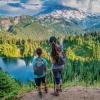Updated July 2008
Like miniature mountains, the fuzzy hillocks of a sphagnum moss bog fuel the imagination. Are they fairy castles? Gnome thrones? The giveaway humps of a hiding dragon's spine? Musing along these lines is part of the charm of visiting this remarkable type of wetland.
"When you reach the hummocks and twisted trees, the whole environment has this Tolkien look to it that really draws kids' attention," says Max Prinsen, surveying a spongy green world from the boardwalk at Shadow Lake Bog in Renton. As co-founders of Save Habitat and Diversity of Wetlands (SHADOW), Prinsen and his wife Erin Wojewodzki-Prinsen have devoted much of the past 11 years to preserving and educating the public about the rare wetland area.
Bogs have been places of awe throughout the ages, and Shadow Lake Bog makes for a lively family outing because of the diversity of habitats packed into a very small area. It's just 1,200 feet from the frog pond near the beginning of the boardwalk to the center of the bog.
Though amphibians can't live in the acidic interior of a true bog, they thrive in the pond at its outskirts. Spring and early summer are good times to visit. You can use dip nets and jars -- available on the dock at the pond -- to meet tadpoles, water bugs and frogs eye-to-eye. Pacific Northwest salamander egg masses are easy to spot because they look like moss-covered oranges, and water striders skate effortlessly across the surface with the help of tiny leg hairs. Two kinds of frogs can be seen here, the Pacific chorus frog and the red-legged frog, named for its pink-tinged legs.
How did the bog come to be? Located adjacent to Shadow Lake, it was formed when a retreating glacier left a bowl-like impression. Little water flows into or out of this natural container, inviting the growth of sphagnum mosses that release tannins and acids, making the water low in oxygen and slowing decomposition. Peat is an organic soil that develops in spots where plants grow more quickly than they can decay, and are compressed by the weight of decades of growth. This bog's 45 to 65 feet of peat took an estimated 5,000 years to accumulate.
In King County, fewer than 3 percent of sphagnum moss peat lands remain, as the rich peat has been mined for use in agriculture and the land filled in for development. This makes Shadow Lake Bog an extraordinary find indeed.
Like other wetlands, bogs help prevent flooding and provide habitat for birds and animals. Their main ecological function is to act as a giant sponge that helps to hold groundwater. On a larger scale, peat lands deter global warming by storing massive amounts of carbon. Bogs are a kind of living museum for scientists, who find buried biological treasures in their peat stores.
"The acidic environment acts as a preservative, and basically pickles things," Prinsen explains.
The creatures we encountered were thankfully still breathing: Red-legged frogs hopped amicably near the pond as garter snakes skated effortlessly over undulating mosses. Rainier Audubon Society has counted more than 80 species of birds here, and the bog is home to unique spiders and insects -- although, luckily for us, mosquito larvae can't live in the acidic waters. The bog is also home to 26 different mosses and lichens, as well as a mycologist's utopia of mushrooms. (One specimen found recently was last seen in 1957!)
Everywhere you look there's something new to discover, and each visitor leaves with a bog story all his or her own. And, perhaps taken in by the magic here, you and your family will want to return again and again.
Kathryn True is a freelance writer who lives with her family on Vashon Island. Ever curious about all things wild, she is the co-author of Nature in the City: Seattle (Mountaineers Books).
Bog basics
Shadow Lake Bog is open to the public by appointment only. Max and Erin like to give first-timers a tour, while repeat visitors can wander the property on their own. Either way, call 425-432-4914 or email info@shadowhabitat.org to arrange your visit. The bog is located at 21818 184th Ave. S.E. in Renton.
Summer events (visit Shadow's Web site for current information)
- Shadow Lake Bog Frog Frolic happens in August. The public is welcome for bog tours, music and theater performances, a raffle and silent auction. Drinks and cake will be provided. Bring a potluck dish to share.
Amphibian etiquette
Make sure to wash and rinse your hands thoroughly (at the Richter Interpretive Center, located on the property) before and after pond exploration, as amphibians have permeable skin that is sensitive to contaminants. Use the jars to view the critters to avoid over-stressing them. If you do pick up a frog, handle it gently for a minute or two, then let it go. Avoid picking up the orange-bellied roughskin newts, which can be found in or around the pond, because they secrete a toxin that can cause skin irritation.
Other bogs to explore
- Roxhill Bog. Reclaimed in-city bog, headwaters of Longfellow Creek and the trailhead for the three-mile-long Longfellow Creek Trail. Located across from Westwood Village at 29th Avenue Southwest and Southwest Barton Street in Seattle.
- West Hylebos Wetlands Park. Features flat, easy boardwalk loop, sinkhole, boglands and interpretive signs. Located in Federal Way between South 348th and Southwest 356th Street and First Avenue South and Pacific Highway South (Hwy 99). 253-929-1519.
- Mercer Slough Nature Park. The 320-acre wetland includes a marsh, bog and ponds, which visitors can traverse by foot or canoe. Trailheads and boardwalks are accessible at Bellevue Way between 112th Avenue Southeast and 118th Avenue Southeast, Bellevue. 425-452-2752.









